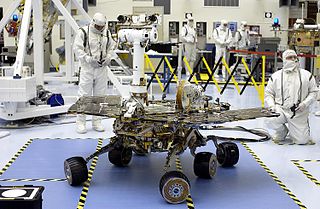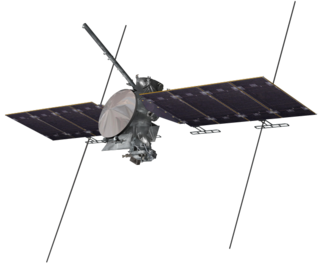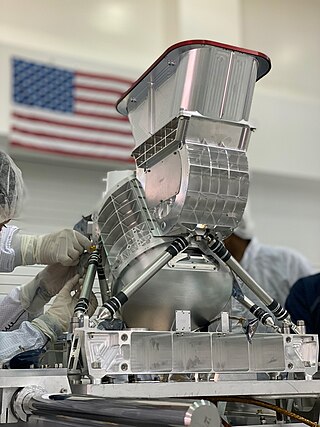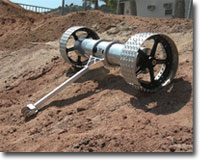Related Research Articles

Jet Propulsion Laboratory (JPL) is a federally funded research and development center in La Cañada Flintridge, California, United States. Founded in 1936 by Caltech researchers, the laboratory is now owned and sponsored by the National Aeronautics and Space Administration (NASA) and administered and managed by the California Institute of Technology.

2001 Mars Odyssey is a robotic spacecraft orbiting the planet Mars. The project was developed by NASA, and contracted out to Lockheed Martin, with an expected cost for the entire mission of US$297 million. Its mission is to use spectrometers and a thermal imager to detect evidence of past or present water and ice, as well as study the planet's geology and radiation environment. The data Odyssey obtains is intended to help answer the question of whether life once existed on Mars and create a risk-assessment of the radiation that future astronauts on Mars might experience. It also acts as a relay for communications between the Curiosity rover, and previously the Mars Exploration Rovers and Phoenix lander, to Earth. The mission was named as a tribute to Arthur C. Clarke, evoking the name of his and Stanley Kubrick's 1968 film 2001: A Space Odyssey.

Mars Pathfinder is an American robotic spacecraft that landed a base station with a roving probe on Mars in 1997. It consisted of a lander, renamed the Carl Sagan Memorial Station, and a lightweight, 10.6 kg (23 lb) wheeled robotic Mars rover named Sojourner, the first rover to operate outside the Earth–Moon system.

Spirit, also known as MER-A or MER-2, is a Mars robotic rover, active from 2004 to 2010. Spirit was operational on Mars for 2208 sols or 3.3 Martian years. It was one of two rovers of NASA's Mars Exploration Rover Mission managed by the Jet Propulsion Laboratory (JPL). Spirit landed successfully within the impact crater Gusev on Mars at 04:35 Ground UTC on January 4, 2004, three weeks before its twin, Opportunity (MER-B), which landed on the other side of the planet. Its name was chosen through a NASA-sponsored student essay competition. The rover got stuck in a "sand trap" in late 2009 at an angle that hampered recharging of its batteries; its last communication with Earth was on March 22, 2010.

Curiosity is a car-sized Mars rover exploring Gale crater and Mount Sharp on Mars as part of NASA's Mars Science Laboratory (MSL) mission. Curiosity was launched from Cape Canaveral (CCAFS) on November 26, 2011, at 15:02:00 UTC and landed on Aeolis Palus inside Gale crater on Mars on August 6, 2012, 05:17:57 UTC. The Bradbury Landing site was less than 2.4 km (1.5 mi) from the center of the rover's touchdown target after a 560 million km (350 million mi) journey.

Adriana C. Ocampo Uria is a Colombian planetary geologist and a Science Program Manager at NASA Headquarters. In 1970, Ocampo emigrated to California and completed her Master in Sciences at California State University, Northridge and finished her PhD at the Vrije Universiteit in the Netherlands. During high school and graduate studies she worked at the Jet Propulsion Laboratory, where she serves as the science coordinator for many planetary missions.

Europa Clipper is a space probe in development by NASA. Planned for launch in October 2024, the spacecraft is being developed to study the Galilean moon Europa through a series of flybys while in orbit around Jupiter. It is the largest spacecraft NASA has ever developed for a planetary mission.

Phobos And Deimos & Mars Environment (PADME) is a low-cost NASA Mars orbiter mission concept that would address longstanding unknowns about Mars' two moons Phobos and Deimos and their environment.
Bonnie J. Buratti is an American planetary scientist in the Division of Earth and Space Sciences at the Jet Propulsion Laboratory in Pasadena, California, where she leads the Comets, Asteroids, and Satellites Group. Her research involves the composition and physical properties of planetary surfaces, and volatile transport in the outer solar system.

Amanda R. Hendrix is an American planetary scientist known for her pioneering studies of solar system bodies at ultraviolet wavelengths. She is a senior scientist at the Planetary Science Institute. Her research interests include moon and asteroid surface composition, space weathering effects and radiation products. She is a co-investigator on the Cassini UVIS instrument, was a co-investigator on the Galileo UVS instrument, is a Participating Scientist on the Lunar Reconnaissance Orbiter LAMP instrument and is a Principal Investigator on Hubble Space Telescope observing programs. As of 2019, she is also the co-lead of the NASA Roadmaps to Oceans World Group.

Christina "Chrissy" Richey is an American planetary scientist and astrophysicist working at Jet Propulsion Laboratory in La Cañada Flintridge, California. Richey is a project staff scientist for the Europa Clipper mission and is a research technologist in the Astrophysics and Space Sciences Section. Prior to working at JPL, Richey worked as contractor for Arctic Slope Regional Corporation at NASA Headquarters in Washington, D.C. They were a program officer in NASA's Planetary Science Division, the deputy program scientist for the OSIRIS-REx mission, and the deputy science advisor for research and analysis for the Science Mission Directorate.

Michael H. Hecht is a research scientist, associate director for research management at the Massachusetts Institute of Technology's Haystack Observatory, and former deputy project director of the Event Horizon Telescope. He served as lead scientist for the Microscopy, Electrochemistry, and Conductivity Analyzer instrument on the Phoenix Mars lander, and as principal investigator for the Mars Oxygen ISRU Experiment (MOXIE) instrument on the Mars 2020 rover.

The Mapping Imaging Spectrometer for Europa (MISE) is an imaging near infrared spectrometer on board the Europa Clipper mission to Jupiter's moon Europa. MISE will examine Europa's surface composition and relate it to the habitability of its internal water ocean.

Sarah Milkovich is lead of Science Operations for the Mars 2020 rover at Jet Propulsion Laboratory. She was investigation scientist for the HiRISE camera on the Mars Reconnaissance Orbiter.

SuperCam is a suite of remote-sensing instruments for the Mars 2020 Perseverance rover mission that performs remote analyses of rocks and soils with a camera, two lasers and four spectrometers to seek organic compounds that could hold biosignatures of past microbial life on Mars, if it ever existed there.

Bethany List Ehlmann is an American geologist and a professor of Planetary Science at California Institute of Technology. A leading researcher in planetary geology, Ehlmann is also the President of The Planetary Society, Director of the Keck Institute for Space Studies, and a Research Scientist at NASA's Jet Propulsion Laboratory.

Moon Diver is a proposed lunar mission concept by NASA's Jet Propulsion Laboratory that would employ a robotic lander and a – distant coaxial – two-wheeled rover called Axel to investigate the exposed geological layers on the walls of a deep lunar pit.
Melissa McGrath is an astronomer whose expertise is the atmosphere and magnetosphere of the Solar System planets and their moons. Her main interest has focused on imaging and spectroscopic studies of Jupiter’s Galilean moons. She is currently co-investigator on the ultraviolet spectrometer instrument on ESA JUICE mission to Ganymede, and co-investigator on two proposed instruments on the NASA Europa Clipper mission. McGrath is senior scientist at SETI Institute in Mountain View, California.
References
- ↑ Chong, Jia-Rui (September 24, 2005), "At ABBA, Go Left to SpongeBob", Los Angeles Times, retrieved 2024-05-06
- ↑ McKinnon, Mika (May 26, 2015), "Here Are The 9 Instruments We'll Use To Reveal The Secrets Of Europa", Gizmodo, retrieved 2024-05-06
- 1 2 3 "Diana Blaney", NASA Science: People (Interview), NASA, retrieved 2024-05-06
- 1 2 3 Curriculum vitae (PDF), Jet Propulsion Laboratory, April 2018, retrieved 2024-05-06
- 1 2 Niebur, Susan (September 24, 2010), "Diana Blaney: Play to Your Strengths", Women in Planetary Science, retrieved 2024-05-06
- ↑ "Diana Lee Blaney", AstroGen, American Astronomical Society, retrieved 2024-05-06
- ↑ "Diana Blaney", People, Jet Propulsion Laboratory, retrieved 2024-05-06
- ↑ "Past DPS Officers", Division for Planetary Sciences, American Astronomical Society, retrieved 2024-05-06